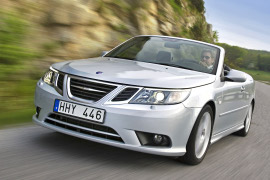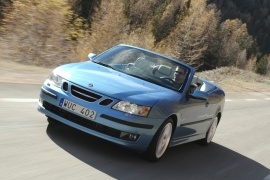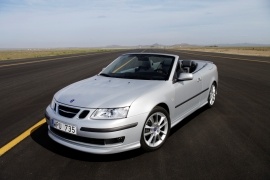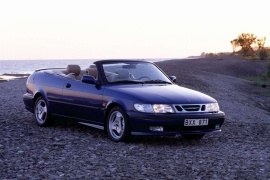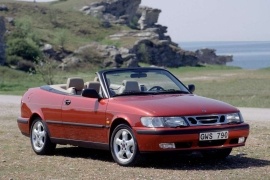SAAB 9-3 Convertible Models/Series Timeline, Specifications & Photos
First production year: 1998
Engines: Gasoline, Ethanol, Diesel
Body style: Convertible (spider/spyder, cabrio/cabriolet, drop/open/soft top)
Affected by the world economic crisis, General Motors had to sell Saab in 2010, but before that, it tried to boost the sales of the Swedish brand, and one of the vehicles that received an update was the 9-3 Cabrio.
Saab built excellent convertibles despite not having too many warm days in its yard. However, thanks to its expertise in a cold-weather environment, it managed to create very good ragtops for the 9-3 Cabrio range.
Saab was known for doing major upgrades on its cars, even if it shouldn't add more burden to the accounting department. Yet, the Swedish engineers and designers preferred to create a completely new front fascia for the 9-3 Cabriolet in 2009. So instead of just changing a bit here and there, they brought massive improvements.
For starters, the new headlights featured the daytime running lights strip atop the headlamps, like a pair of eyebrows. Also, the bumper was new and integrated the front grille and a new lower apron. Moreover, the hood sported a new design. Some might consider that they should've stopped there, but no. Instead, the design team moved on and installed clear-lenses taillights and, obviously, a new bumper. It didn't care that all these costs were the icing on the cake in GM's decision to sell the brand.
Inside, the dashboard and the center stack were also redesigned, even though GM's management told Saab to just slightly improve them, so it could fit the carmaker's infotainment unit. As a result, not even the gateway for the automatic transmission gear selector kept its shape. This resulted in a much more refined cabin with high-quality finishes and not that cheap materials.
Under the hood, Saab added more engines to the lineup, gasoline and turbodiesels. In addition, the older five-speed automatic transmission was gone, and a new six-speed was added to the options list for selected powerplants.
While it was still under GM's control, Saab introduced a new generation of the 9-3 in 2002, while in the following year, it unveiled the convertible version.
Even though the 9-3 was not available as a coupe, the carmaker decided to build a convertible version for this lineup, besides the sedan and the station wagon. It was heavier than its siblings and was less fuel-efficient than those. Still, it achieved its objective: to offer a more pleasant driving experience.
The new front fascia was already established by its siblings, but it was slightly enhanced, raising the production costs and driving GM's execs mad in their Detroit offices. Nevertheless, though, the car looked both elegant and sporty. Its tilted headlights and specific grille that resembled an aircraft were accompanied by a lower apron with an extended lower lip. That was not added there just for aerodynamic purposes but also to enhance pedestrian protection. Saab was a brand focused on safety. From its profile, the thick A-pillars were the only ones that had to protect the occupants in an unlikely event of a roll-over accident. Behind the cabin, a hardcover protected the canvas roof when retracted and featured a pair of bulges. At the back, depending on the trim level, the 9-3 Convertible featured a small lip spoiler on the trunk's lid.
Inside, the leather-wrapped interior was standard for the upper trim level. The front bucket seats provided enhanced side support thanks to the high-bolstered areas. However, even though it was advertised as a convertible with four seats, the rear passengers were not very happy with the legroom provided. Last but not least, the trunk was not that spacious either.
Under the hood, Saab installed a choice of engines from its own basket or carried over from General Motors, such as the turbo-diesel units.
SAAB 9-3 Convertible 1.8L 5AT FWD (150 HP)
SAAB 9-3 Convertible 1.8L 5MT FWD (150 HP)
SAAB 9-3 Convertible 2.0L 5AT FWD (175 HP)
SAAB 9-3 Convertible 2.0L 5MT FWD (175 HP)
SAAB 9-3 Convertible 2.0L 6MT FWD (175 HP)
SAAB 9-3 Convertible 2.0L TS 5AT FWD (210 HP)
Saab introduced the second generation of the 9-3 lineup in 2002 based on GM's Epsilon platform shared with other European products, and in 2003 it unveiled the open-top version for it.
The Swedish automaker reworked the platform to create the open-top version, and as a result, the 9-3 Convertible shared just a few parts with other GM vehicles, leading to a steep price. Still, the car was highly appreciated by its customers since it offered unique features unseen on other vehicles on the market.
The 9-3 featured a grille that showed a sketched plane viewed from the front, which resembled the company's heritage. Its sharp-looking headlights with corner-mounted turn signals showed the brand's determination to succeed. The thick, racked A-pillars were also used as protection in case of a roll-over crash. From its profile, the 9-3 showed a slightly ascending belt line that ran toward the back of the vehicle. The power-operated canvas roof could've been retracted and completely concealed in a dedicated storage area behind the cabin.
Inside, Saab installed its brand-specific functions, such as the night panel that lit only the speedometer, the ignition placed between the seats, and the high-bolstered seats for the front occupants. Yet, in the back, there was little knee room for rear-seated passengers, but it was just enough for short trips.
Under the hood, the 9-3 Convertible received a wide choice of engines, depending on the market.
Saab used its former 900 Convertible underpinnings when it made the 9-3 Convertible since GM owned them for barely a year before the car was unveiled.
The Swedish carmaker was a surprising star in the open-top vehicles market since it was not a warm country. Despite all odds, Saab managed to create a different convertible, and its customers were happy with that unique look and feel. GM tried to make the brand more profitable and understood that the open-top version was a good deal, so it gives them the green light.
At the front, the Saab-specific headlights with their swept design flanked the aero-inspired grille. Its front bumper sported a wider central grille on the lower side, flanked by fog lights. The raked windshield and the thick A-pillars were the only body elements that raised over the ascending beltline. Unlike other convertibles on the market, the 9-3 featured a high trunk, and the carmaker built the car, so in the event of a roll-over accident, the occupants' heads wouldn't touch the ground.
For the interior, Saab 9-3 featured the main company's characteristics such as the starter key between the seats, a big center console, and the "Night Panel" function that shut down all the unnecessary information during the night and let only the speedometer lit. Since the carmaker had to push the rear seats slightly forward to make room for the retractable roof, the legroom for the rear passengers was very minimal.
Under the hood, Saab installed its own designed 2.0-liter turbocharged engine. The carmaker offered it with either a five-speed manual or a four-speed automatic.
The Saab 9-3 range was introduced in 1998 as a successor of the 900 series. It was offered as a hatchback, a coupe, and a convertible. It was developed and produced under GM management.
Even if there are not so many days to drive with the top down in Sweden, the Swedish company built convertibles since its first model, the 92 (1952), which featured a textile roof (also known as cabrio-coach vehicles). Unlike its ancestors, the 9-3 was a true convertible.
The 9-3 featured the same front design as its coupe sibling, but it didn't have the sloped trunk-lid or, at least, not as obvious. Since the car shared its platform with the Opel/Vauxhall Vectra, it had to use some of its components. The wide headlights and the specific trapezoidal grille decorated the front fascia. The raked A-pillars were thick and served as a safety roll-over protection. With its ascending beltline, the engineers stated that if the car was upside down, the occupants had a big chance to survive if the seatbelts were used. Saab was the first car-maker to fit that safety device in the world and gave the rights to use it for free to all car-makers.
Inside, the Saab tried to compete with the premium vehicles. Its dashboard was big and the center stack took its inspiration from the aircraft industry. A “Night Panel” function was carried-over from its bigger brother, the 9-5. Once activated, the entire instrument panel was shut down and left only the speedometer lit.
For the engine-compartment, the 9-3 Convertible was offered with a wide choice of gasoline engines, most of them being turbocharged. The standard transmission for the entire range was a 5-speed manual while a 4-speed automatic was available.
SAAB 9-3 Convertible 2.0L 4AT FWD (130 HP)
SAAB 9-3 Convertible 2.0L 4AT FWD (150 HP)
SAAB 9-3 Convertible 2.0L 4AT FWD (154 HP)
SAAB 9-3 Convertible 2.0L 5MT FWD (130 HP)
SAAB 9-3 Convertible 2.0L 5MT FWD (150 HP)
SAAB 9-3 Convertible 2.0L 5MT FWD (154 HP)
SAAB 9-3 Convertible 2.0L Turbo 4AT FWD (185 HP)
SAAB 9-3 Convertible 2.0L Turbo 4AT FWD (205 HP)
SAAB 9-3 Convertible 2.0L Turbo 5MT FWD (185 HP)
SAAB 9-3 Convertible 2.0L Turbo 5MT FWD (200 HP)
SAAB 9-3 Convertible 2.0L Turbo 5MT FWD (205 HP)
SAAB 9-3 Convertible 2.3L 4AT FWD (150 HP)
